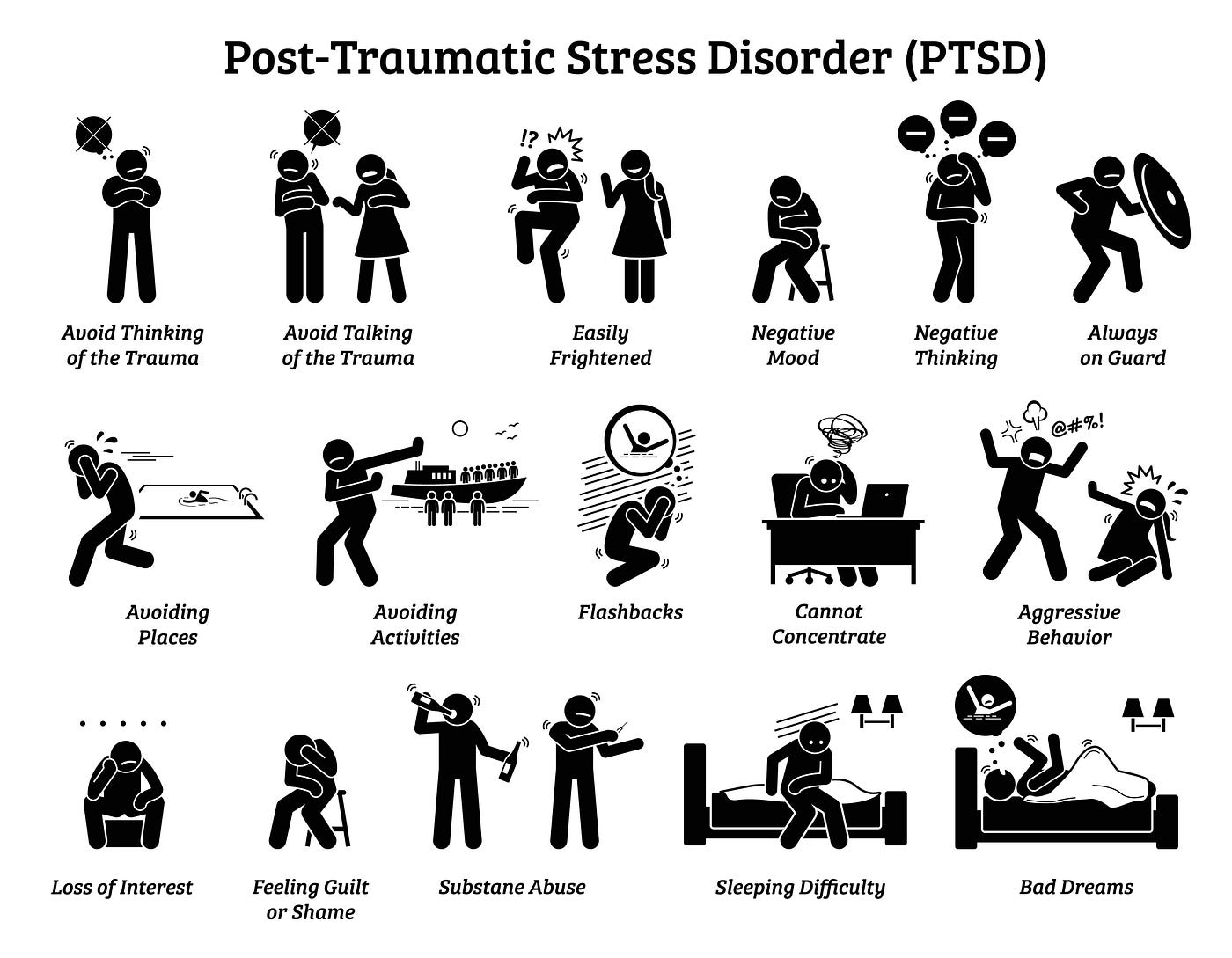

Finance
Why Are Trauma Bonds So Hard To Break
Published: October 12, 2023
Discover the powerful impact of trauma bonds in finance and understand why breaking free from them is such a challenging journey.
(Many of the links in this article redirect to a specific reviewed product. Your purchase of these products through affiliate links helps to generate commission for LiveWell, at no extra cost. Learn more)
Table of Contents
- Introduction
- What are Trauma Bonds?
- The Role of Emotional Attachment
- The Power of Fear and Control
- Reinforcement through Intermittent Reward
- The Impact of Isolation and Dependency
- The Cycle of Trauma Bonding
- Signs of a Trauma Bond
- The Difficulty in Breaking Trauma Bonds
- Overcoming Trauma Bonds
- Seeking Professional Help
- Conclusion
Introduction
When it comes to human relationships, we often think of bonds that form through love, trust, and mutual respect. But there is another type of bond that is not as easily broken – trauma bonds. These bonds are formed in situations where there is abuse, manipulation, or intense emotional experiences, and they can have a profound impact on an individual’s life.
Trauma bonds are not exclusive to romantic relationships; they can also form in friendships, family dynamics, or even in the workplace. What makes trauma bonds particularly challenging to break is the complex interplay of emotions, attachment, fear, and control.
In this article, we will explore the nature of trauma bonds, how they are formed, and why they can be incredibly difficult to break. Understanding these dynamics is crucial for anyone who has been in a toxic or abusive relationship and wants to heal and move forward.
It’s important to note that trauma bonds can affect anyone, regardless of gender, age, or background. Whether you’ve experienced a traumatic relationship or know someone who has, this article will shed light on the intricate nature of trauma bonds and provide insights into the journey of breaking free.
What are Trauma Bonds?
Trauma bonds, also known as Stockholm Syndrome, refer to the strong emotional attachments that develop between individuals in abusive or highly stressful situations. Unlike healthy bonds based on love and respect, trauma bonds are characterized by fear, control, and manipulation.
These bonds typically form in situations where there is a power imbalance, such as in abusive relationships or cults. The victim becomes emotionally dependent on the abuser, often due to a cycle of pain, reward, and intermittent reinforcement. This creates a complex web of emotions that can make it incredibly challenging to break free.
One of the key characteristics of trauma bonds is the emotional attachment that forms. In order to survive the abuse or trauma, the victim develops a deep bond with the perpetrator as a means of self-preservation. This strong attachment can create mixed emotions of love, loyalty, and even empathy towards the abuser.
Trauma bonds are also characterized by a sense of isolation and dependency. The victim may feel trapped, believing that they have no alternative options or that leaving the relationship would be detrimental to their well-being. This dependency is often reinforced by the abuser, who manipulates the victim’s beliefs and emotions.
Additionally, trauma bonds are reinforced through intermittent reinforcement. This means that the abuser alternates between moments of kindness, affection, or apologies and periods of cruelty, control, or manipulation. This unpredictable pattern of reward and punishment further deepens the emotional bond and confuses the victim.
It’s important to note that trauma bonds can occur in various forms of relationships, including romantic partnerships, familial connections, or even in institutional settings such as cults or hostage situations. Regardless of the context, trauma bonds have a significant impact on the mental, emotional, and even physical well-being of the individuals involved.
The Role of Emotional Attachment
Emotional attachment plays a central role in the formation and perpetuation of trauma bonds. When individuals experience intense emotions, especially in the context of abuse or trauma, their attachment system becomes activated. This system is responsible for forming deep emotional connections with others in order to establish a sense of safety and security.
In the case of trauma bonds, the attachment system becomes hijacked. The victim’s emotions become entangled with their abuser, leading to a distorted sense of attachment. This emotional attachment can be seen as a survival mechanism that the victim develops to cope with the abuse and maintain a sense of connection.
The trauma bond often manifests as a combination of fear, love, and loyalty towards the abuser. On one hand, the victim may experience genuine affection and love for their abuser, as they may have had positive experiences or moments of kindness. On the other hand, they also feel intense fear and anxiety, which further strengthens the attachment to the abuser.
This emotional attachment can lead to a deep sense of confusion and cognitive dissonance for the victim. They may find themselves questioning their own feelings and perceptions as they try to make sense of the complex dynamic they are experiencing.
In some cases, the emotional attachment may also stem from a deeply ingrained belief that the abuser is the only source of love or validation. The victim may have been made to believe that they are unworthy of love or that no one else would care for them. As a result, they become emotionally dependent on their abuser and cling to the belief that the abuser is the only one who can provide the love and acceptance they crave.
Breaking the trauma bond requires a deep understanding of the emotional attachment and the underlying beliefs that fuel it. It involves gradually unraveling the confusion and disentangling the victim’s emotions from the abuser, allowing them to create healthier and more authentic connections in the future.
The Power of Fear and Control
Fear and control are fundamental components of trauma bonds. Abusers often use fear as a tool to maintain power and control over their victims. By instilling fear, they manipulate their victims into submission, ensuring their compliance and perpetuating the trauma bond.
The consistent presence of fear in a traumatic relationship creates a state of heightened anxiety and hypervigilance. The victim becomes conditioned to anticipate and please the abuser in an attempt to avoid further harm. This fear-driven behavior serves to reinforce the trauma bond, as the victim associates the abuser with both the source of their fear and their perceived protector.
Control is another crucial element in the formation and sustenance of trauma bonds. Abusers exert control over their victims through various tactics, such as isolating them from friends and family, manipulating their thoughts and emotions, or even using physical violence. This control reinforces the power dynamic and reinforces the dependency of the victim.
Abusers strategically employ tactics to induce a sense of learned helplessness in their victims. By constantly undermining their self-esteem and belittling their abilities, the abuser ensures that the victim feels incapable of escaping the abusive situation. This reinforces the belief that the abuser has complete control and leaves the victim feeling helpless and trapped.
The combination of fear and control creates a cycle that perpetuates the trauma bond. The victim may believe that staying in the relationship is the only way to avoid further harm or protect their loved ones. The abuser, in turn, may oscillate between moments of charm and kindness, giving the victim glimpses of hope and reinforcing the belief that things can change.
Breaking free from the power of fear and control requires immense strength and courage. It involves recognizing and confronting the abusive dynamics, reclaiming one’s sense of autonomy and self-worth, and establishing boundaries that protect against further harm.
It is important for survivors to remember that they are not alone in their journey to break free from the power of fear and control. Supportive networks, including friends, family, or professional resources, can provide invaluable assistance and guidance throughout the healing process.
Reinforcement through Intermittent Reward
One of the key factors that make trauma bonds so hard to break is the reinforcement that occurs through intermittent rewards. In abusive relationships, abusers often employ a pattern of alternating between moments of kindness, affection, or even apologies, and periods of cruelty, control, or manipulation.
This unpredictable cycle of rewards and punishments has a powerful psychological impact on the victim. It creates a sense of hope and longing for the positive aspects of the relationship, making it difficult to let go or break free from the trauma bond.
When the abuser is kind or appears remorseful, the victim experiences a surge of relief, happiness, and a renewed sense of love and connection. These intermittent rewards can be incredibly powerful, overshadowing the negative experiences and reinforcing the belief that the abuser has the capacity to change.
Additionally, the intermittent reinforcement creates a state of cognitive dissonance for the victim. They may find themselves making excuses for the abuser’s behavior, rationalizing that the moments of kindness outweigh the traumatic experiences. This mental process further strengthens the trauma bond and makes it even harder to break.
The unpredictable nature of intermittent rewards also creates a cycle of hope and anticipation. The victim may constantly strive to please the abuser, believing that if they do everything right, the relationship will improve or the abuse will stop. This cycle perpetuates the trauma bond and keeps the victim trapped in the abusive dynamic.
Overcoming the reinforcement through intermittent reward requires a shift in mindset and a recognition of the truth behind the cycle. Breaking free from the trauma bond involves acknowledging that the moments of kindness or remorse do not excuse or justify the abuse. It also requires understanding that true change and healing are unlikely to come from the abuser.
Creating a support system and seeking professional help can also be instrumental in breaking the cycle. Supportive friends, family, or therapists can provide perspective, validation, and guidance throughout the healing journey. They can help individuals recognize and navigate the patterns of intermittent reward and develop strategies to build healthier relationships in the future.
The Impact of Isolation and Dependency
Isolation and dependency are critical elements that contribute to the strength and durability of trauma bonds. Abusers often employ tactics to isolate their victims from external support systems, such as family, friends, or professional networks. This isolation serves to increase the victim’s dependency on the abuser and further entrench the trauma bond.
Isolation can take various forms, including limiting social interactions, monitoring and controlling communication channels, or even physically cutting off the victim from external resources. This isolation not only prevents the victim from seeking help or finding alternative perspectives but also reinforces the abuser’s control over their thoughts and actions.
Dependency, both emotional and financial, is another crucial aspect of trauma bonds. Abusers often foster a sense of reliance in their victims, making them believe that they are incapable of functioning independently or that they need the abuser’s support to survive. This dependency can further strengthen the emotional attachment and make it incredibly challenging for the victim to break free.
Moreover, abusers may manipulate the victim’s self-esteem and self-worth, leading them to believe that they are unworthy of love, support, or any other connections outside the abusive relationship. The victim may feel helpless and convinced that they have no alternatives or that leaving the relationship would lead to dire consequences.
The impact of isolation and dependency on the victim’s psychological well-being cannot be overstated. The victim may suffer from low self-esteem, anxiety, and depression, further perpetuating the belief that they are undeserving of better treatment or a life outside the trauma bond.
Breaking free from the impact of isolation and dependency requires a multifaceted approach. It involves reconnecting with external support systems, rebuilding social connections, and embracing one’s own autonomy and capabilities. This process may be gradual and may require the support of professionals, such as therapists or support groups, who can provide guidance and validation throughout the journey.
It is essential for survivors to recognize that they are not alone and that there are resources available to help them regain their independence. Rebuilding a support network and seeking assistance can empower individuals to reclaim their lives and break free from the chains of isolation and dependency.
The Cycle of Trauma Bonding
The cycle of trauma bonding refers to the repetitive pattern that occurs within a traumatic relationship. This cycle involves a series of stages that reinforce the trauma bond and make it incredibly challenging to break free.
The first stage of the cycle is idealization, where the abuser presents themselves as kind, charming, and loving. During this phase, the victim is showered with affection, attention, and often feels a deep sense of connection and happiness. This idealization creates a strong emotional attachment and sets the foundation for the trauma bond.
The next stage is the devaluation phase, where the abuser begins to exhibit controlling, manipulative, or abusive behavior. This phase undermines the victim’s sense of self-worth, erodes their confidence, and instills fear and confusion. The victim may feel trapped, questioning their own perception of reality, and justifying the abuser’s behavior.
Following the devaluation phase is the discard phase, where the abuser withdraws attention, love, or validation. This withdrawal leaves the victim feeling abandoned, rejected, and desperate for the abuser’s validation. The sudden absence of the positive aspects of the relationship intensifies the trauma bond and further reinforces the victim’s dependency on the abuser.
After the discard phase, the cycle often repeats with the abuser returning to the idealization phase. This cycle of idealization, devaluation, and discard continues, creating a repetitive pattern that deeply ingrains the trauma bond. Each cycle reinforces the belief that the abuser has the power to change or provide love and validation.
It is important to note that the duration and frequency of each stage within the cycle can vary. Some cycles may be shorter or longer, and the intensity of the abuse can also differ. However, the repetitive nature of the cycle remains consistent, making it difficult to break free from the trauma bond.
Breaking the cycle of trauma bonding requires a deep understanding of the dynamics at play and a commitment to self-care and healing. It involves recognizing and accepting the reality of the abusive relationship, setting boundaries, seeking support from trusted individuals, and working with therapists or support groups to develop healthier coping mechanisms and establish new patterns in relationships.
This journey of breaking the cycle of trauma bonding requires immense strength, resilience, and patience. It is important for survivors to remember that healing is possible, and there are resources available to support them on their path to freedom and recovery.
Signs of a Trauma Bond
Recognizing the signs of a trauma bond is crucial for individuals who may be caught in an abusive or toxic relationship. While every situation is unique, there are several common indicators that may suggest the presence of a trauma bond:
- Deep Emotional Attachment: Feeling intense affection, loyalty, or even love towards the abuser despite their abusive behavior.
- Fear and Anxiety: Experiencing constant anxiety, fear, or hypervigilance around the abuser, or feeling extreme emotional distress when considering leaving the relationship.
- Dependency: Relying heavily on the abuser for validation, decision-making, or emotional support, and feeling incapable of functioning without their presence.
- Isolation: Being socially isolated or cut off from friends, family, or support networks due to the abuser’s control or manipulation.
- Excusing Abusive Behavior: Making excuses for the abuser’s actions, rationalizing their behavior, or blaming oneself for the abuse.
- High Tolerance for Mistreatment: Accepting and becoming numb to repeated instances of abuse, rationalizing them as normal or deserved.
- Difficulty Leaving: Feeling trapped or unable to leave the relationship, despite recognizing its toxicity or potential danger.
- Cycle of Idealization and Devaluation: Observing a pattern of the abuser alternating between being excessively loving and affectionate and being controlling, manipulative, or abusive.
- Loss of Self-Identity: Feeling a loss of one’s own identity, values, and needs due to the constant focus on pleasing the abuser and meeting their demands.
- Diminished Self-Esteem: Experiencing low self-esteem, self-blame, or a belief that one is unworthy of love or better treatment.
It is important to remember that experiencing one or more of these signs does not automatically indicate a trauma bond. However, if these signs resonate with your experience or that of someone you know, it may be a signal to seek help, support, and resources to address the situation.
Recognizing the signs of a trauma bond is a crucial first step towards breaking free and healing from an abusive or toxic relationship. Seeking professional guidance from therapists specializing in trauma or reaching out to support networks can provide the necessary tools and support to navigate the journey of recovery.
The Difficulty in Breaking Trauma Bonds
Breaking trauma bonds is an incredibly challenging and complex process. The strong emotional attachment, fear, control, and reinforcement that characterize trauma bonds make it difficult for individuals to break free from the toxic dynamics. Here are some reasons why breaking trauma bonds can be so difficult:
- Emotional Attachment: Trauma bonds often involve intense emotional attachment to the abuser, which can create conflicting feelings of love, loyalty, and even empathy. This emotional attachment can make it challenging to disentangle oneself from the relationship.
- Dependency: Individuals in trauma bonds may develop a deep sense of dependency on their abuser. They may believe that they need the abuser for validation, basic survival needs, or financial support. This dependency can be reinforced by the abuser’s control and manipulation.
- Cognitive Dissonance: Trauma bonds can create a state of cognitive dissonance, where the victim experiences conflicting thoughts and beliefs. They may simultaneously recognize the abuse while still holding onto the hope that the abuser can change or the belief that they are responsible for the abuse.
- Intermittent Reinforcement: The combination of intermittent rewards and punishments from the abuser further reinforces the trauma bond. The periods of kindness or affection can create a sense of hope and attachment, despite the presence of abuse.
- Guilt and Shame: Victims of trauma bonds often experience feelings of guilt, shame, or self-blame which can keep them trapped in the cycle. They may believe that they deserve the abuse or that leaving the relationship would hurt the abuser or their family.
- Isolation: Abusers often employ tactics to isolate the victim from external support systems, leaving them feeling alone and without resources. This isolation can make it difficult to seek help or see other perspectives on the abusive relationship.
- Hope for Change: Despite the abuse, victims may hold onto hope that the abuser can change. They may remember the initial idealization phase of the relationship and believe that if they just do or say the right things, the abuse will stop.
Breaking trauma bonds requires immense strength, support, and resources. It often involves a combination of therapy, support groups, and the rebuilding of social networks. Recognizing the challenging nature of breaking trauma bonds is crucial to provide empathy, understanding, and support to those who are on this difficult journey to healing and independence.
Overcoming Trauma Bonds
Overcoming trauma bonds is a challenging and deeply personal journey towards healing and reclaiming one’s life. While the process may vary for each individual, there are some common steps that can help facilitate the process of breaking free from the trauma bond:
- Recognize the Abuse: Acknowledging and accepting that the relationship is abusive is a crucial first step. This requires acknowledging the patterns of control, manipulation, and mistreatment.
- Validate Your Experience: It is important to validate your own feelings and experiences. Recognize that you are not to blame for the abuse and that your emotions are valid.
- Build a Support System: Surround yourself with a supportive network of friends, family, or support groups. Having allies who understand and believe your experience can provide validation and strength.
- Seek Professional Help: Consider reaching out to therapists or counselors specializing in trauma and abusive relationships. They can provide guidance, tools, and coping strategies tailored to your specific needs.
- Develop Self-Care Practices: Engage in activities that promote self-care and self-compassion. This could include exercise, journaling, meditation, or engaging in hobbies that bring joy and fulfillment.
- Set Boundaries: Establish clear boundaries to protect yourself from further harm. This may involve limiting or cutting off contact with the abuser, setting limits on their behavior, and prioritizing your safety and well-being.
- Educate Yourself: Learn more about trauma bonding, codependency, and the dynamics of abusive relationships. Understanding the psychological mechanisms at play can help you make sense of your experience and break free from the cycle.
- Work Towards Independence: Focus on regaining your autonomy and building a life outside of the trauma bond. This may involve acquiring new skills, seeking employment, or pursuing hobbies and interests that empower you.
- Practice Self-Reflection and Healing: Engage in self-reflection to address any underlying beliefs or wounds that may have contributed to the formation of the trauma bond. Explore therapy modalities such as cognitive-behavioral therapy (CBT), dialectical behavior therapy (DBT), or trauma-focused therapy to support your healing journey.
- Be Patient and Kind to Yourself: Healing from trauma bonds takes time. Be patient with yourself and practice self-compassion as you navigate the ups and downs of the healing process. Celebrate even the smallest victories along the way.
Remember that overcoming trauma bonds is a courageous and transformative process. Each step you take towards healing is a step towards reclaiming your autonomy, self-worth, and a future filled with healthier, more fulfilling relationships.
Seeking Professional Help
Seeking professional help is a crucial component of overcoming trauma bonds and healing from the effects of abusive relationships. While the support of friends and family is important, trained professionals can provide specialized guidance and therapeutic interventions to assist individuals in their journey towards recovery.
Therapists and counselors who specialize in trauma, domestic violence, or abusive relationships can offer a safe and nonjudgmental space for survivors to explore their experiences, emotions, and challenges. They are trained to understand the complexities of trauma bonds and can provide valuable insights and techniques to address the underlying issues.
There are various therapeutic approaches that professionals may use to support clients in healing from trauma bonds:
- Cognitive-Behavioral Therapy (CBT): CBT helps individuals identify and challenge negative thought patterns and beliefs related to themselves and the trauma bond. It focuses on building healthier coping skills and strategies for breaking free from the cycle of abuse.
- Dialectical Behavior Therapy (DBT): DBT can be effective in helping individuals regulate their emotions and develop healthy boundaries. It emphasizes distress tolerance, emotional regulation, interpersonal effectiveness, and mindfulness.
- Trauma-Focused Therapy: This approach specifically targets the effects of trauma, helping individuals process their traumatic experiences and develop strategies to manage trauma-related symptoms. Techniques such as eye movement desensitization and reprocessing (EMDR) or somatic experiencing may be used.
- Support Groups: Joining support groups, either in-person or online, can provide a sense of community, understanding, and validation. Peer support can be instrumental in realizing that others have experienced similar trauma bonds and are on a path towards healing.
Professional help can also provide safety planning and resources for individuals who may be at risk of further harm or need assistance in leaving a dangerous situation. Therapists can collaborate with legal professionals or domestic violence shelters to ensure the safety and well-being of their clients.
It is important to remember that seeking professional help is not a sign of weakness, but rather a courageous step towards healing and reclaiming one’s life. If you or someone you know is struggling with a trauma bond, consider reaching out to a qualified professional who can provide the support and guidance needed for the journey towards recovery.
Conclusion
Trauma bonds are powerful and complex emotional attachments that form in abusive or highly stressful relationships. The combination of fear, control, intermittent reinforcement, isolation, and emotional dependency makes trauma bonds incredibly difficult to break. Individuals find themselves caught in a cycle of idealization, devaluation, and discard, struggling to extricate themselves from toxic dynamics.
Recognizing the signs of a trauma bond is the first step towards healing. It requires acknowledging the emotional attachment, fear, and dependency that contribute to the strength of the bond. Breaking free from trauma bonds involves a multifaceted approach, including building support systems, seeking professional help, setting boundaries, and developing self-care practices.
Seeking professional help is essential in the healing process. Therapists and counselors specialized in trauma and abusive relationships can provide invaluable guidance, validation, and therapeutic interventions tailored to individual needs. They can help survivors navigate complex emotions, address underlying wounds, and develop tools to break free from the trauma bond.
Overcoming trauma bonds is not an easy journey. It requires courage, patience, and self-compassion. Healing involves reclaiming autonomy, rebuilding self-esteem, and establishing healthier relationships based on respect and mutual support.
Remember that you are not alone in this process. Reach out to friends, family, support groups, and professionals who can provide a safe and understanding space. With the right support and resources, it is possible to break free from the grip of trauma bonds and forge a path towards a brighter and healthier future.














